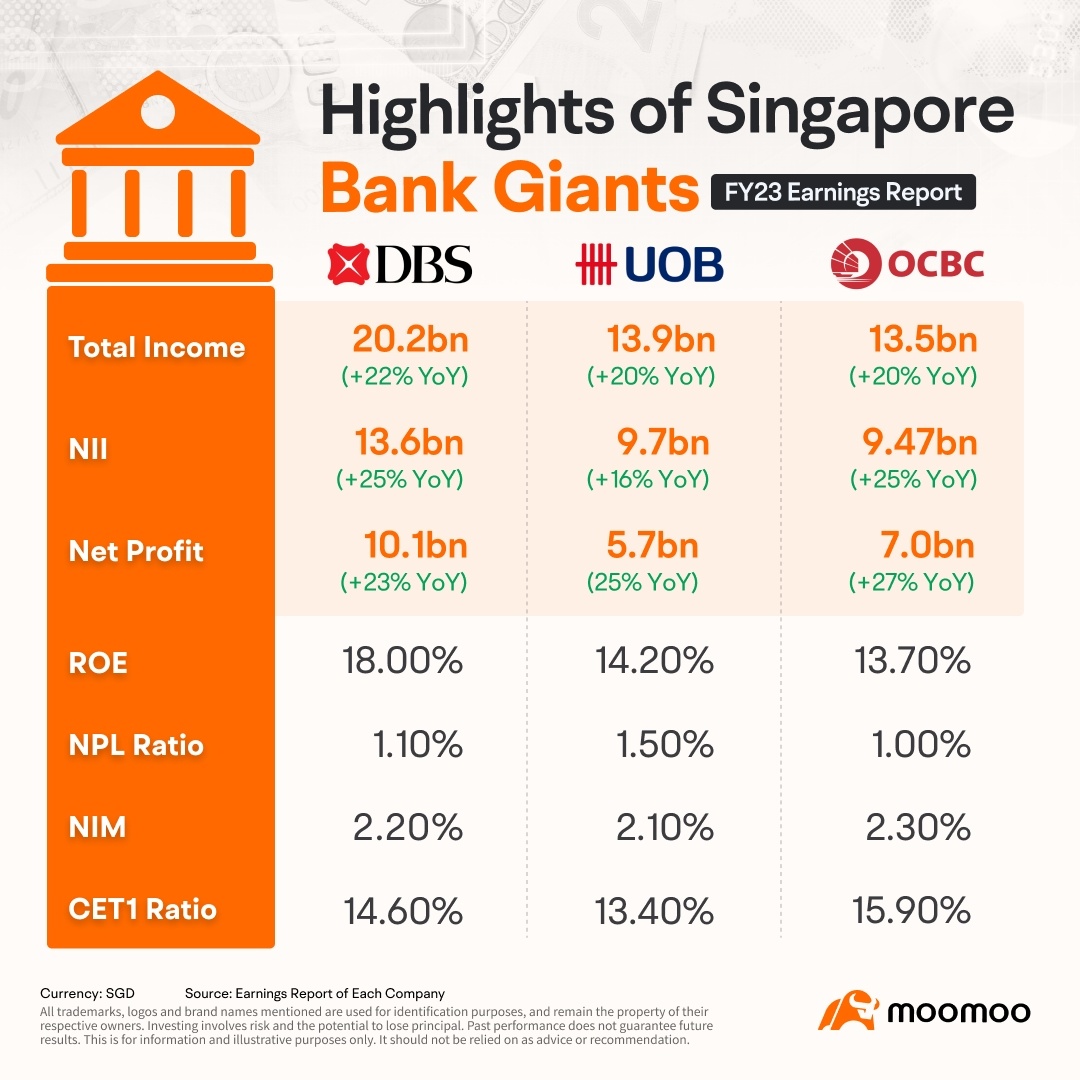Singapore Banks: Revenue Up in 2023, NIM Challenges Ahead in 2024
Following the close of the quarter ending December 31, 2023, $DBS Group Holdings(D05.SG$ Bank led the charge by unveiling its fourth-quarter and full-year financial results on February 7. This was followed by $UOB(U11.SG$, which disclosed its earnings on February 22. Lastly, $OCBC Bank(O39.SG$ released its performance figures on February 28, rounding out the earnings season for Singapore's banking sector.
FY23 has seen a climate of soaring interest rates and a sturdy economy, positioning the banking sector among the clear victors. Benefiting from a solid loan portfolio and elevated net interest margins, banks have achieved unprecedented revenue and profit growth.
Singapore's top three banks have shown strong results, with revenues and net profits up by about 20% and 26%, respectively, marking 2023 as a robust year for the industry.

NIM Fortunes Diverge in Q4
Although all three banks achieved growth in NII for the full year, there were disparities in performance among the companies in Q4.
DBS reported a 5% year-on-year increase in net interest income (NII), hitting S$3.4 billion in Q4, propelled by a rise in net interest margin (NIM) of 8 bps to 2.13%, in an environment of sustained high interest rates. Additionally, the merger with Citi Taiwan accounted for an injection of S$10 billion into the loan portfolio.
UOB's Q4 NII fell 6% YoY, with NIM down 20bps to 2.02%, primarily caused by tighter loan margins from competitive pressures for quality credits, while loan volumes remained unchanged year-over-year. UOB's speedy integration of Citigroup's retail business in Malaysia, Thailand, Vietnam, and Indonesia will extend its Southeast Asian footprint, boosting its deposit base, loan book, and wealth business.
OCBC's Q4 net interest income rose 3% YoY to S$2.46 billion, driven by a 4% growth in average assets. However, NIM fell slightly by 2bps to 2.29% due to increased funding costs outpacing gains in asset yields.
However, interest rates are anticipated to decrease in the future, seen as a certainty. Meanwhile, banks face higher funding costs that can't be transferred to customers because of competition. If economic downturns push rates lower, maintaining high NIM spreads will be challenging for banks.
Fee Income Surge on Wealth, Card Growth
DBS's Q4 fee income surged 31% YoY to S$867 million, driven by gains in cards and wealth management, with a slight dip in transaction service fees.
UOB experienced a 17% annual increase in fee income in Q4, bolstered by robust credit card fee performance and a resurgence in wealth management fees, alongside a moderate uptick in loan-related fees in a wary investment environment.
OCBC's Q4 non-interest income climbed by 25% to S$811 million, driven by a surge in net fee income of 16%, amounting to $460 million. This increase was attributed to enhanced fee generation in wealth management, credit card operations, and loan-related services.
Solid NPL Ratios Maintained
The three banks maintained stable non-performing loan ratios. DBS held steady at a 1.1% NPL ratio, unchanged from the previous year. OCBC improved, reducing its NPL ratio to 1% from 1.2%. UOB marginally bettered its position, slightly decreasing its NPL ratio to 1.5%, down 0.1 percentage points from last year.
Positive Sector Outlook
Singapore's top banks—DBS, OCBC, and UOB—are all expecting an upswing in fee income, albeit with various outlooks on other financial metrics for FY24.
DBS projects a double-digit increase in fee income, primarily fueled by wealth management and credit card fees. The bank expects stable NII, as gains from increased NIM due to persistently high rates will be balanced by a slowdown in loan growth.
OCBC anticipates a rise in fee income as wealth management gains traction in the second half. Moreover, OCBC forecasts a NIM ranging between 2.2% and 2.25%, a slight decrease from 2023's figure of 2.28%. The bank's margin is projected to be more resilient than its peers.
UOB sees rising fee income from cards and wealth management amid better market mood, yet faces a tough 2024 with tight margins and soft lending dampening interest earnings. Loan growth may be muted but could pick up from Citigroup's retail integration.
Source: Bloomberg, Phillip Capital, The Straits Times
Disclaimer: Moomoo Technologies Inc. is providing this content for information and educational use only.
Read more
Comment
Sign in to post a comment
